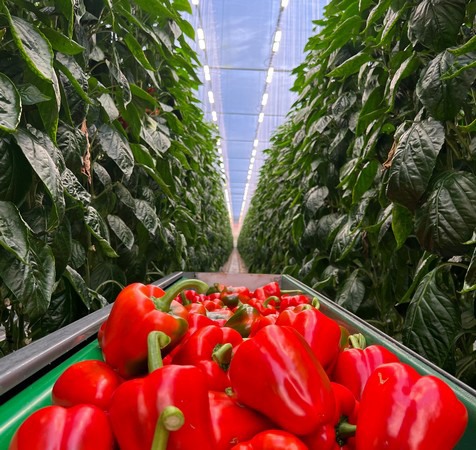Innovative new lighting technology will let Ontario vegetable greenhouses grow peppers all year long. That’s the result of a project funded through the Greenhouse Competitiveness and Innovation Initiative (GCII), which also found that the smart LED grow lights system results in higher yields, better quality and more uniform crops.
Expanding production to 12 months of the year in Ontario, North America’s largest greenhouse vegetable-growing region, helps boost the competitiveness of the greenhouse vegetable sector and strengthen domestic food security by increasing the availability of locally grown vegetables.
Conventional greenhouse lighting systems rely on High Pressure Sodium (HPS) lighting that doesn’t work well on pepper crops, making year-round production expensive and challenging.

To work on the project, Allegro Acres formed a consortium with smart LED grow lights solution company Sollum Technologies in Montreal and teamed up with the Harrow Research and Development Centre, the University of Windsor, Golden Jem Produce and Ontario Greenhouse Vegetable Growers.
“LEDs are up to 40% more efficient, longer-lasting and more sustainable over traditional lighting – and will let us eliminate night sky light pollution while maintaining an optimal environment for our crop,” explains Gene Ingratta of Allegro Acres, host greenhouse of the project trials. “In the past, though, LED technology has been very expensive and not readily available, so we were keen to try the Sollum system.”
Results
In 2020, four acres of peppers at Allegro were grown under Sollum’s lights, and the research team experimented with different photoperiods, light intensities and spectra, and pepper varieties. The LED-lit area was expanded to 12 acres last year and refined on the second year of pepper crops, combining up to 24 hours of continuous light with low-intensity lighting control techniques.
“We found that light spectrum and photoperiods can be very variety-specific; for example, some need far more red than others, or certain varieties will take less energy and still produce the same yield,” Ingratta says, adding they’re now working closely with seed companies to try and develop varieties that are LED-friendly in order to achieve maximum production with the most energy savings.
With the right varieties growing under the smart LED grow lights system, he expects 20 to 30% more production from peppers that are deliver quality, more flavourful and have longer shelf life.
That’s because the light spectrum and intensity from the Sollum fixtures can easily be adjusted to create ideal growing conditions to match specific variety needs and respond to environmental changes. As well, the lights automatically dim when sunlight comes out, reducing hydro costs for growers and ensuring the plants get exactly the right amount of light all the time.
“This trial with Sollum’s LED lighting technology was a big risk and a big experiment for everyone involved in the project, and without the partnership and the GCII, it would have been difficult to make it happen,” says Ingratta. “LED technology is double the cost of the HPS lighting to install, but it’s much more efficient and sustainable in the long-term.”
“To increase the resilience of our food supply, it’s important to have local greenhouse production throughout the winter, and this technology is an excellent example of how we can make that happen in Ontario,” adds Doug Alexander, Chair of the Agricultural Adaptation Council, the GCII delivery agent. “This lighting system can also be adapted to other greenhouse vegetable crops, which will help advance the sustainability and competitiveness of this industry in our province.”
“Increasing the productivity of greenhouse vegetables throughout the year means that Ontario greenhouse vegetable growers can be more competitive in domestic and global markets,” says Lisa Thompson, Minister of Agriculture, Food and Rural Affairs. “Helping farmers grow their business builds resiliency into the agri-food sector and strengthens the economy.”
For more information:
Laura Feil Agricultural Adaptation Council
Agricultural Adaptation Council
381 Elmira Road North, Unit 1
Guelph, ON N1K 1H3
P: 519-822-7554
F: 519-822-6248
lfeil@adaptcouncil.org
adaptcouncil.org
